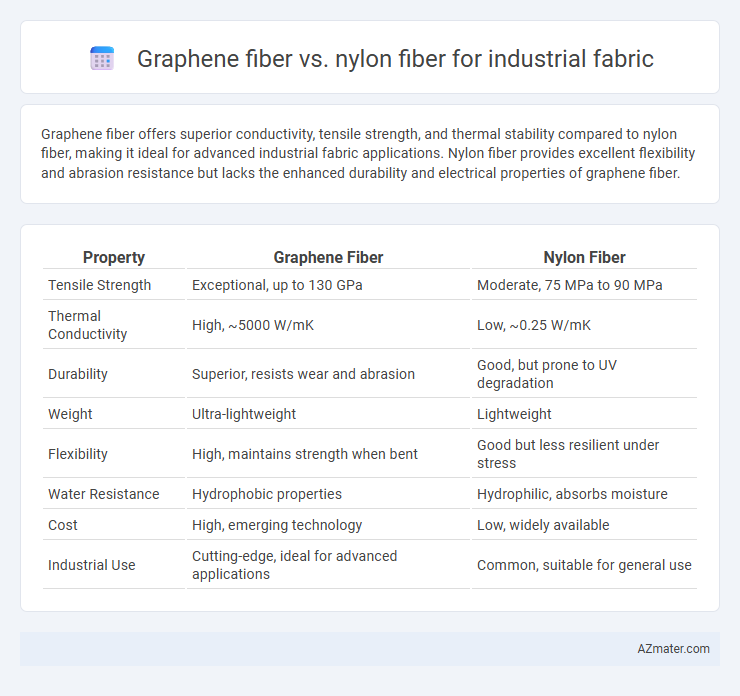Graphene fiber offers superior conductivity, tensile strength, and thermal stability compared to nylon fiber, making it ideal for advanced industrial fabric applications. Nylon fiber provides excellent flexibility and abrasion resistance but lacks the enhanced durability and electrical properties of graphene fiber.
Table of Comparison
| Property | Graphene Fiber | Nylon Fiber |
|---|---|---|
| Tensile Strength | Exceptional, up to 130 GPa | Moderate, 75 MPa to 90 MPa |
| Thermal Conductivity | High, ~5000 W/mK | Low, ~0.25 W/mK |
| Durability | Superior, resists wear and abrasion | Good, but prone to UV degradation |
| Weight | Ultra-lightweight | Lightweight |
| Flexibility | High, maintains strength when bent | Good but less resilient under stress |
| Water Resistance | Hydrophobic properties | Hydrophilic, absorbs moisture |
| Cost | High, emerging technology | Low, widely available |
| Industrial Use | Cutting-edge, ideal for advanced applications | Common, suitable for general use |
Introduction to Graphene and Nylon Fibers
Graphene fiber, derived from a single layer of carbon atoms arranged in a hexagonal lattice, offers exceptional strength, electrical conductivity, and thermal stability, making it a groundbreaking material for industrial fabrics. Nylon fiber, a synthetic polymer known for its toughness, elasticity, and resistance to abrasion and chemicals, has been a staple in industrial textile applications for decades. The integration of graphene fibers in industrial fabrics provides enhanced mechanical properties and conductivity, potentially surpassing traditional nylon fibers in performance and durability.
Material Composition and Structure
Graphene fiber consists of carbon atoms arranged in a hexagonal lattice, offering exceptional tensile strength and electrical conductivity due to its two-dimensional atomic structure, while nylon fiber is a synthetic polymer made from polyamide chains, known for its elasticity and abrasion resistance. The molecular arrangement in graphene fiber results in superior thermal conductivity and mechanical properties compared to the semi-crystalline structure of nylon fibers, which provide flexibility and moisture absorption. Industrial fabrics utilizing graphene fibers benefit from enhanced durability and conductivity, whereas nylon fibers contribute to lightweight, resilient textiles suitable for a broad range of applications.
Mechanical Strength Comparison
Graphene fiber exhibits superior mechanical strength compared to nylon fiber, with tensile strength reaching up to 1300 MPa, significantly higher than nylon's average tensile strength of 75-90 MPa. The high Young's modulus of graphene fiber, approximately 1000 GPa, enhances stiffness and durability, making it ideal for heavy-duty industrial fabric applications. In contrast, nylon fibers, while flexible and resistant to abrasion, lack the exceptional load-bearing capacity and structural integrity offered by graphene-based materials.
Flexibility and Elasticity Analysis
Graphene fiber exhibits superior flexibility compared to nylon fiber due to its nanoscale thickness and high tensile strength, enabling it to bend without fracturing under stress. Elasticity analysis reveals that graphene fiber maintains its shape and recovers more efficiently from deformation, with an elastic modulus significantly higher than nylon's, offering enhanced durability in industrial fabric applications. The combination of flexibility and elasticity in graphene fibers results in materials that outperform nylon in resistance to wear, tear, and mechanical fatigue, critical for industrial use.
Thermal Conductivity Differences
Graphene fiber exhibits thermal conductivity values reaching up to 5000 W/m*K, significantly outperforming nylon fiber, which typically ranges around 0.25 W/m*K. This high thermal conductivity in graphene fibers enhances heat dissipation and temperature regulation in industrial fabric applications, offering superior performance in environments with extreme thermal conditions. Industrial fabrics incorporating graphene fibers provide improved durability and safety by efficiently managing heat compared to traditional nylon-based textiles.
Chemical and Environmental Resistance
Graphene fiber exhibits superior chemical resistance compared to nylon fiber, effectively withstanding exposure to acids, bases, and solvents without degradation, making it ideal for harsh industrial environments. Nylon fiber, while durable, is more prone to chemical attack and hydrolysis, which can compromise fabric integrity over time. Environmentally, graphene fiber offers enhanced resistance to UV radiation and extreme temperatures, ensuring longer service life and sustainability in industrial applications.
Durability and Wear Performance
Graphene fiber exhibits superior durability and wear resistance compared to nylon fiber in industrial fabric applications due to its exceptional tensile strength and resilience to abrasion. Studies show graphene-reinforced fabrics maintain structural integrity under extreme stress, significantly outperforming nylon's typical wear lifespan. Consequently, graphene fiber offers enhanced longevity and reliability for heavy-duty industrial environments requiring robust material performance.
Industrial Applications and Use Cases
Graphene fiber boasts exceptional strength, electrical conductivity, and thermal stability, making it ideal for advanced industrial applications such as aerospace, wearable technology, and smart textiles that require lightweight and durable materials. Nylon fiber remains widely used in industrial fabrics for its abrasion resistance, flexibility, and cost-effectiveness, commonly applied in conveyor belts, protective clothing, and upholstery. The choice between graphene and nylon fibers depends on specific industrial requirements, with graphene fiber excelling in high-performance, multifunctional applications and nylon fiber providing reliable performance for conventional uses.
Cost Efficiency and Scalability
Graphene fiber offers superior strength-to-weight ratio and electrical conductivity compared to nylon fiber, enhancing durability and functionality in industrial fabrics but comes with higher production costs currently limiting cost efficiency. Nylon fiber remains more cost-effective and easier to mass-produce, providing scalable solutions for large-scale industrial fabric manufacturing. The scalability of graphene fiber is improving with advances in synthesis techniques, gradually reducing costs and increasing its viability for commercial applications.
Future Prospects and Innovations
Graphene fiber offers exceptional strength, conductivity, and lightweight properties that significantly outperform traditional nylon fibers in industrial fabric applications, promising enhanced durability and multifunctionality. Innovations in graphene fiber integration aim to create smart fabrics with self-healing capabilities, improved thermal management, and superior chemical resistance. Future prospects focus on scalable production methods and hybrid composites that blend graphene with nylon to optimize cost-efficiency and performance in industrial settings.

Infographic: Graphene fiber vs Nylon fiber for Industrial fabric
 azmater.com
azmater.com